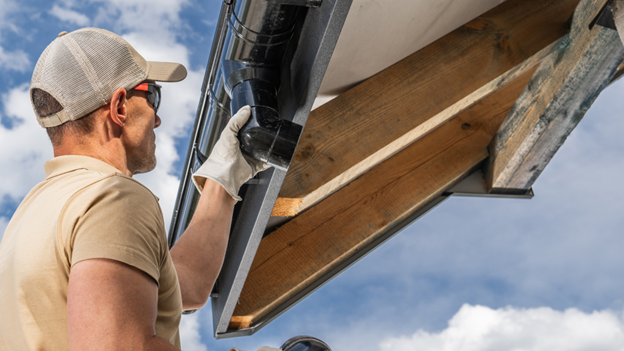Your downspouts are a critical component of your home’s water management system. While gutters collect rainwater from your roof, it’s the downspouts that carry it safely away from your home’s foundation. When they’re functioning properly, you probably don’t think twice about them. But when they’re not doing their job, the consequences can be serious—and expensive.
Here are six warning signs that your downspouts might be failing, and what to do about it before the next storm hits.
1. Water Pooling Near the Foundation
One of the most obvious signs of a failing downspout is standing water around your home’s foundation after it rains. Downspouts are supposed to direct water at least several feet away from your home. If water consistently pools near the base of your house, it’s a sign that your downspouts are either too short, disconnected, or clogged.
Over time, this pooling can lead to soil erosion, foundation cracks, basement leaks, or even mold problems. If you’re seeing puddles where there shouldn’t be any, it’s time to inspect your system and possibly look into downspout installation Carmel professionals rely on to ensure proper drainage.
2. Erosion in Your Landscaping
Have you noticed washed-out mulch, exposed roots, or channels in your soil where water seems to rush through? Improperly functioning downspouts can create fast-moving water streams that destroy your landscaping over time. What’s worse, this erosion can extend to areas under your driveway or sidewalk, creating hollow pockets that eventually crack or collapse.
A well-functioning downspout system will gently disperse water or route it underground to avoid damaging the surrounding terrain. If your yard looks like a mini river ran through it after every rain, that’s a red flag.
3. Staining on Exterior Walls
If water isn’t being directed properly away from the house, it often ends up running down your exterior walls. Over time, this leads to unsightly streaks or stains—especially on siding, brick, or stucco. These water stains may appear dark, rusty, or moldy, depending on what’s being carried in the runoff.
Staining can indicate that your downspouts are leaking, misaligned, or detached from the gutter system. It’s also a sign that water is not being guided to the ground as it should be, potentially exposing your walls and insulation to moisture damage.
4. Basement Dampness or Flooding
If you’re dealing with a musty basement, damp walls, or recurring water seepage, your downspouts might be to blame. When rainwater isn’t being directed away from the foundation, it can seep through the concrete and into the basement. Even a small amount of consistent moisture can lead to mold growth and structural issues over time.
Many homeowners focus on waterproofing the inside of their basement, but the issue often starts on the outside—with failing or poorly positioned downspouts. A simple change in how water is redirected can sometimes solve long-standing moisture problems.
5. Rust, Cracks, or Separation at the Seams
Downspouts aren’t indestructible. Over time, they can rust, crack, or pull apart at the seams—especially in older systems or those made from thinner materials. These imperfections may not seem like a big deal at first, but they can lead to water escaping before it ever reaches the ground.
Even small leaks along the downspout can allow water to run down the siding or pool in unwanted areas. If you notice sections pulling away from the house or holes forming in the downspout, it’s time to replace that section or upgrade the whole system.
6. Mold or Mildew Around the Home’s Exterior
Mold and mildew need moisture to grow. If you’re noticing green or black patches forming around your foundation, near your siding, or on patios and porches, it’s a sign that water isn’t being redirected properly. This often happens when water from misaligned or leaking downspouts is allowed to consistently saturate parts of your home’s exterior.
Mold and mildew not only affect your home’s appearance and structure, but they can also cause health issues. Addressing the root cause—poor drainage—will help eliminate the moisture that allows these fungi to thrive.
If you’ve noticed any of these signs, it’s essential to take action before the damage gets worse. Sometimes, cleaning a clogged downspout or reattaching a loose connection can solve the issue. In more serious cases, you may need a completely new system—especially if your home lacks enough downspouts or if they’re improperly sized or placed.
A proper downspout installation service homeowners trust will ensure that rainwater is guided safely away from the home, protecting your foundation, siding, and landscaping from costly damage.
Downspouts are easy to overlook—until they stop doing their job. Whether it’s water damage, erosion, or basement leaks, the consequences of neglected downspouts can be more severe than most homeowners expect. Fortunately, the fix is often straightforward. By keeping an eye out for the signs and addressing them early, you can protect your home and avoid future headaches.

